KEY
HC= Highly Corrosive MC= Mildly Corrosive LE= Limited Effect NC= Non-Corrosive
Due to the various chemicals, gases and cleaners within a manufacturing plant, it is imperative to cover metal parts with VCI Packaging as soon after production or processes as possible. Contamination on components is a problem that, depending on the level of cleanliness required, can be extremely serious.
The above chart indicates various gases and their corrosive effects on metals. Whenever possible, it is best to wrap metal parts inside a vapour tight barrier of Volatile Corrosion Inhibitor (VCI) Packaging, to eliminate the possibility of corrosive gases from affecting the component. Technology Packaging provide a full range of best-fit products aimed at making sure customers goods arrive in pristine condition at the lowest cost. Technology Packaging advice is FOC as are the Packaging Audits it can carry out on your or your suppliers packaging. Furthermore, free training can be provided on corrosion and corrosion protection.
To obtain a quote, request a sample or technical support please call
+44 (0) 203 598 19 19 or visit our enquiry page. EXPERT KNOWLEDGE AND QUALITY PRODUCTS ARE NOT EXPENSIVE – THEY’RE INVALUABLE
0 Comments
1. Rinse and DRY Packaging metal parts before they are dry Stacking or packing metal parts into boxes after being taken directly out of a cleaning solution without thoroughly drying them will result in rust. When washing or cleaning parts, do not stack or package them until completely dry. Wet parts rust when stacked on top of each other because the fluid acts as an electrolyte and forms a galvanic cell between the two parts. SOLUTION: Make sure metal parts are thoroughly dried before stacking them or packing them into boxes. Placing metal parts in a wire basket allows them to air dry quickly. Vibratory action, forced air, and heat can also dry parts more quickly. Soon after the metal parts are dry, package them in TechCorro™[P] VCI paper or TechCorro™[F] VCI film to prevent corrosion from occurring.  2. Keep it Clean! Dirty cleaning solution causes corrosion Small metal particles, also called swarf, in the metalworking or cleaning solution can end up on metal parts. If not properly washed away, these particles can form a galvanic corrosion cell and corrosion will occur underneath the swarf. SOLUTION: Keep your metalworking fluids and cleaning solutions clean and free of dirt and swarf. Fluids and solutions should be checked on a regular basis and kept free of contaminants that can cause corrosion. 3. Dirty Water Using public/city water for cleaning fluids or water-based rust inhibitors Public/city water can contain high chlorine levels and other chemicals that can cause corrosion. The pH of public/city water can also vary greatly. As we will see in the next most common reason for corrosion, proper pH also plays an important role in preventing rust and corrosion on metal parts. SOLUTION: Switch from public/city water to distilled or deionized water. Additionally, use Dry Coat™ Rust Preventative Spray which is a ready-to-use, water-based rust inhibitor. 4. Adjust the pH! Improper pH level of cleaning solutions Proper pH levels depend on the type of the metal parts. For ferrous parts, a pH level of at least 9.0 should be maintained. For nonferrous metal parts such as copper and alloys like brass and bronze, a pH level of 7.0 - 7.5 should be maintained. SOLUTION: Regularly check and correct pH levels of all cleaning solutions. Adjust pH levels according to usage guidelines.  5. Never Play With Fire! Storage of metal parts near manufacturing areas Metal parts stored close to manufacturing areas, specifically heat-treating and grinding processes, can become contaminated which leads to corrosion. SOLUTION: Cover all metal parts with TechCorro™[P] VCI paper or TechCorro™[F] VCI film to protect them. 6. Keep Your Cool! Failure to maintain the proper temperature in manufacturing and shipping areas For every 10 degree Celsius increase in temperature, corrosion rates can double. Fluctuations in temperatures cause metal pores to open and can also cause condensation to form on parts. Condensation becomes an electrolyte, allowing corrosion to occur. High humidity can cause electrolytes to form on the surface of metal parts enabling the corrosion cell to form and allowing corrosion to propagate. When packaging parts in high humidity that kind of atmosphere is being locked into the package. SOLUTION: Maintain lower temperatures and lower humidity levels by installing climate controls, air conditioning, and/or dehumidifiers. 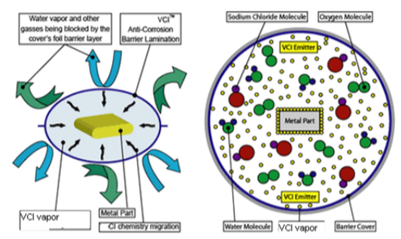 7. Cover Up! Leaving metal parts uncovered and unprotected Leaving parts uncovered while sitting in the plant, waiting for secondary operations, in queue for additional machining, drilling and tapping, waiting to be packaged, etc. makes parts susceptible to rust and corrosion. Parts left uncovered in the plant are susceptive to forklift exhaust. Chlorides, sulfides, and oxides from the exhaust contribute to the corrosion of metal parts. SOLUTION: Cover all metal parts with TechCorro™[P] VCI paper or TechCorro™[F] VCI film, protecting them from oxygen and contaminants that are in the plant atmosphere.  8. Caught Red-Handed! Employees handling metal parts with bare hands Fingerprints and perspiration are one of the biggest contributors to corrosion. Acids, oils, and contaminants on human hands can cause and accelerate corrosion. SOLUTION: All employees who handle metal parts including production workers, inspectors, and packaging personnel should always wear gloves when handling parts.  9. Not So Eco-Friendly Direct contact of metal parts with corrugated cardboard, wood, or paper All forestry products (wood, paper, or corrugated board) contain moisture, acids, and chlorides that cause corrosion. Direct contact with these materials causes “contact corrosion” meaning parts will rust in the areas of direct contact that is made with these products. This often causes sporadic rust having some parts in a particular shipment with rust and others without. Under certain conditions some glues used in corrugated cardboard may give off corrosive gasses. SOLUTION: Line boxes, crates, etc. with TechCorro™[P] VCI paper or TechCorro™[F] VCI film. This creates an effective barrier between metal parts and the wood sourced products that cause rust. 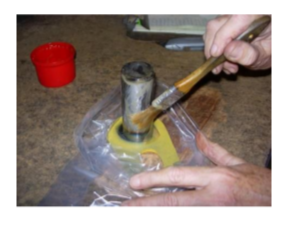 10. Oil Doesn’t Mix Use of rust preventative oils instead of VCI packaging R.P. Oils are the traditional method of preventing rust and corrosion. However, R.P. Oils are messy, labour intensive, and bad for the environment. R.P. Oils are less effective than VCI products when it comes to preventing rust. SOLUTION: The obvious solution to this mistake is to switch from R.P. Oils to TechCorro™[P] VCI paper, TechCorro™[F] VCI film, or Dry Coat which is a waterbased, rust inhibitor liquid. We have successfully helped hundreds of companies switch to TechCorro™ products from R.P. Oils producing great results! 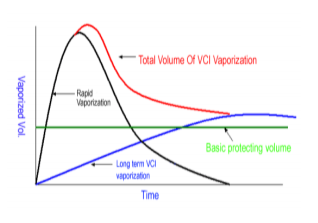 11. Know the Product Improper use of VCI products due to lack of knowledge Another common reason for corrosion on metal is using poor quality VCI products. Too high a vapour pressure will cause the inhibitor to be released to such an extent that a protective concentration cannot be maintained. On the other hand, a low vapour pressure inhibitor is not used up as quickly and can assure more durable protection, but more time is needed for a protective vapour concentration. Proper selection of volatile compounds enables controlled and dependable volatilisation. SOLUTION: Always follow TechCorro™ usage guidelines when using TechCorro™ products. Consult with an expert to design a VCI system for your specific application and help you implement the usage of TechCorro™ products properly. Technology Packaging team members are always happy to help.  12. Can’t Get Enough VCI! Not using enough VCI product The internal space needs to be saturated with VCI vapour before the VCI can condensate on the metal surface. If the amount of VCI is not sufficient, a protective concentration may never be reached. More than 1000 types of VCI compounds are known, but only a fraction of them are efficient, cost effective, and environmentally friendly. SOLUTION: As a general rule, use 1 m² (10 ft²) of TechCorro™[F] VCI film for every 1 - 2.5 m² (10 - 25 ft²) of metal surface. Use at least 4-6 m² of TechCorro™[P] VCI paper for every 1m3 of void space.  13. Do the Homework Lack of knowledge and training Technology Packaging cannot control variable conditions such as temperature, humidity, airflow, end-user production methods, surface area of metal to be protected, customer employee training, and other factors that are beyond our control. It is impossible to guarantee any shelf life in this regard. However, Technology Packaging does guarantee the amount of VCI that is impregnated into the packaging for two years. SOLUTION: Make sure to follow TechCorro™ usage guidelines and train all employees accordingly. Technology Packaging provide bespoke packaging and corrosion preventive training to its customers. 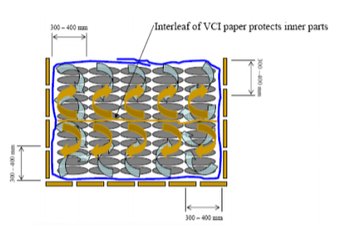 14. Protection Radius Improper placement of VCI products The corrosion protection radius depends on the vapour pressure of the VCI used in the master-batch formulation. Ingredients with higher vapour pressure can reach farther areas and are usually called Vapour Phase Protectors. Ingredients with lower vapour pressure only reach areas in close proximity and are usually called Contact Phase Protectors. SOLUTION: VCI vapours from TechCorro™[P] VCI paper can diffuse into the air up to 30cms. Under normal circumstances don’t place metal parts beyond 30cms away from the closest VCI source unles you check with Technology Packaging’s team.  15. Condensation! Moisture: the main corrosion promoter. Moisture accelerates corrosion. Moisture can cause normal temperature variations to be accentuated inside of a package making air move upwards, like in a chimney. As air either heats or cools, it flows up and down inside the package causing temperature variations and repeated evaporation and condensation. Condensation and evaporation cycles will repeatedly bring contaminates in contact with the metal surface as well as provide thermal conductivity promoting temperature gradients and electrical potential differences on the metal surface.  SOLUTION: Stuff TechCorro™[P] VCI paper into the packaging to prevent the chimney effect and block any air flow. Another solution is the use of TechCorro™ Desiccant to absorb moisture inside of the package. VCI is the generic term for “volatile corrosion inhibitor” also known as “vapour corrosion inhibitor”. We have posted many technical articles on our blog about various types of VCI products and VCI packaging so we thought it would be a good idea to explain exactly what VCIs are and how they work. First off - what IS a Volatile Corrosion Inhibitor? Simply put they are chemical compounds that can reduce the rate of corrosion of ferrous metals like steel and nonferrous metals like copper and alloy. VCIs can be incorporated into different materials and come in various guises depending on the application they are to be used for including films, papers and cardboard and liquid corrosion inhibitors. You will find information and guides to the various types of VCI formulations on our website. VCI compounds comprise several different chemicals but they do NOT clean off rust that has already formed. VCIs are widely used in packaging to protect metal parts during storage and transportation. Other uses include protection of electrical installations, storage tank liners and even the interior of large enclosed spaces.. So how does a Volatile Corrosion Inhibitor work? ● The VCI compounds emit vapour molecules from the carrier material (paper, film, bag etc) ● The atmosphere becomes saturated with VCI. ● The VCI compounds are attracted to the surface of the metal and bonds to it. ● The VCI molecules migrate into hard to reach areas on even the most complex shapes. ● This affects the electro-chemical reaction and forms a protective layer on the metal surfaces, which greatly reduce the possibility of rust and corrosion. How long does a Volatile Corrosion Inhibitor work? The VCI can protect for several years depending on many factors including temperature, storage conditions, type of metal and other packaging. It is therefore important to use the correct VCI product for your particular requirements and Technology Packaging’s team can advise you on your packaging. Where can I find more information?
Help and advice is only a phone call away and will cost your nothing! Our complete range of specialist corrosion preventive packaging uniquely provides us with the ability to give you the best solution for your business. If you have a packaging problem you can Telephone: +44 (0)20 3598 1919 Email: [email protected] Find further information Compare VCI Products  There exists a wide range of protective packaging products which can be used for protecting ferrous and non-ferrous metals from corrosion during storage and shipping. The most effective of these products use VCI technology - Volatile Corrosion Inhibitors. VCI packaging products are available in different mediums to suit a range of applications including papers, films, foams, bags, cardboard, wire, plastic and liquid. In this article we are focusing on VCI packaging paper. There are several formats of VCI paper packaging such as cut sheets, rolls, plain, creped, bags or with poly coating. These packaging papers protect your metal parts from corrosion when the VCI nanomolecules are attracted to the metal surfaces and form a thin microscopic layer of protection which stops the corrosion cell from forming. The best of these VCI papers also offer protection at a distance which ensures all parts are protected without the need to wrap each individual item even when a piece is not in direct contact with the packaging. Quality VCI packaging paper may also be coated on both sides which can simplify packaging and provide the highest protection levels.  Because of the differences in metallurgical make-up it is important to choose the correct VCI paper formulation for your metal corrosion problem. It is possible to test samples to identify the best VCI paper type to use and we have compatibility charts if required. High quality VCI paper provides an extremely effective solution to corrosion preventative packaging and is clean, safe and easy to use. By using VCI paper to protect your metal products it avoids the mess of using oil and grease based products while protecting metal parts with an easy to apply solution. VCI paper is also fully recyclable unless it is the polythene coated version and can be recycled in normal paper recycling systems. If you would like further information or advice on which VCI paper to use for your packaging solution we will be happy to advise and you can also request samples on our website. In our next post we’ll cover the use and application of VCI films for protective packaging.  Corrugated board and made-up cartons impregnated with specially formulated chemical compounds will provide corrosion protection for ferrous and non-ferrous metals. This state-of-the-art corrosion preventive packaging is saturated with VCI chemical to provide a fast-acting and long-lasting protection and is available both as one-sided and two-sided material. You can find detailed information on the metals protected and any compatibility issues on our compatibility charts. How VCI Cartonboard Provides Protection VCIs emit small amounts of harmless active corrosion inhibitors. They are attracted to the charged surface of the metal. The flow of electrons in the metal and the flow of ions in the electrolyte surface is unable to operate and corrosion is halted. The length of protection depends on many factors and Technology Packaging staff are available to answer specific questions on corrosion protection or to provide detailed, objective proposals on suitable methods. This is true whether the problem relates to new projects or existing problematic transit and/or storage systems. Using VCI Carton Material This material can be ‘layered’ between components because VCI works at a distance as well as in contact with the metal. The corrugated material provides cushioning against mechanical damage. Technology Packaging can supply information on the quantity of VCI material required for a pack. VCI Corrugated paper material can be supplies sheets, wide and narrow rolls and die-cut formats. Advice for Handling VCI Cartonboard Ideally the material should be kept cool, dry and protected from direct sunlight. It is preferable to keep it in its original wrapping when possible. If kept in these conditions the material will be effective for a minimum of three years. Skilled technicians are constantly reviewing & developing new products that are often customer led. If you would like to know more about protecting your valuable manufactured goods during storage and transit please get in touch. Protective Packaging Solutions Corrosion protection methods require the components to be ‘clean’ and often Metal Working Fluids are used just before the components are packed for transit. Their correct use in applications and processes are important and TechCorro™ VCI products work more efficiently on uncontaminated metal surfaces. Metalworking fluids are represented by a wide variety of liquids used in the processes associated with reshaping metal objects into a desired form. They have evolved significantly over time to enhance particular performance characteristics and to alleviate health, safety and environmental concerns. The use of metalworking fluids can be traced back at least as far as the 16th century, and probably reaches back much further. The use of whale oil or animal fat and water were replaced with products derived from petroleum driven by the requirements associated with the development of the automotive, aerospace and other industries. The main purposes of these fluids is to ease the manufacturing of metal components by providing lubricity, temperature moderation, corrosion inhibition and metal fines removal. These qualities are of great importance in the metalworking processes classified as cutting, abrading and metal forming. We may loosely define cutting to include processes that separate metal chips from the work piece. Examples of cutting processes would be milling, drilling, turning, boring, threading, broaching and sawing. Abrading (rubbing the surface to a more refined finish) processes would include lapping, polishing and grinding. Metal forming (changing the shape by pressure) is represented by processes such as stamping, drawing, rolling, forging and extrusion. In the cutting and abrading processes, lubrication is an extremely desirable trait to have in a metalworking fluid as it prevents galling, tool chatter and seizing in the metal-to-metal contact area between the tool and the work piece. Temperature moderation, through cooling of the tool-work piece interface, is another leading factor in determining the appropriate fluid for a particular application. The removal of heat stabilizes both the tool’s and the work piece’s surfaces. Together, cooling and lubricity provide longer tool life, narrower tolerances and a better surface finish. Other advantages of the correct metalworking fluid are a cleaner cutting area (with the flushing-out of accumulated metal chips and fines) and the benefit of corrosion mitigation on the machinery and work piece with a rust preventative additive. It should be kept in mind that the rust inhibitors in metalworking fluids are there to help with corrosion inhibition during in-process steps and should not be considered as a long-term protection solution. No metalworking fluid is applicable to every application, in fact they are specifically formulated for particular applications, processes and metal types. These products are generally defined by the process in which they are used. For instance, a cutting fluid or coolant often functions in both capacities. The nomenclature depends on the context in which it is used. Fortunately for our purposes, most of these products will fall into one of four classifications.  1. Straight Metalworking Oils Straight metalworking oils are mineral, vegetable or canola oil based fluids that contain no water and may contain various additives which promote better wettability and lubrication (such as EP, extreme pressure additives). They are generally used in low speed applications and with difficult to machine metals such as stainless steel. The advantages of straight oils are very good lubrication, little chance of skin irritation, good corrosion protection and easy maintenance. The disadvantages are poor heat removal, high viscosity, flammability, potentially hazardous mist and they tend to be expensive. 2. Emulsifiable Oils Emulsifiable (also called water soluble) oils are not truly water soluble but are actually an emulsification of the oil in water. This means that the oil is separated into very small droplets and uniformly dispersed throughout the solution. When added to water they will turn milky white. Emulsification is achieved by introducing an emulsifier which reduces the surface tension between the water and the oil, allowing the oil to be dispersed. Like other metalworking fluids, they contain additives to reduce foaming and improve performance characteristics. Advantages of emulsifiable oils include good lubrication, good heat removal (water has excellent cooling capabilities but it also is a corrosion promoter), they have some corrosion protection potential, they are less of a skin irritant than metalworking fluids that contain no oil (oil lessens the chance of the skin drying out, dermatitis), they are not flammable and are relatively inexpensive. Some of the associated disadvantages are that they require more maintenance and anti-bacterial packages (biocides inhibit the growth of bacteria, fungus and mold), they are sensitive to hard water, have an irritating mist and are susceptible to contamination from foreign oils (such as tramp oils which could be lubricants and hydraulic fluids from the metalworking machinery). 3. Semi-synthetic Metalworking Fluids Semi-synthetic metalworking fluids are water-based products that incorporate both oil emulsions and synthetic lubricants. Because they contain both oil and synthetic components, they have some of the advantages and disadvantages associated with emulsifiable oils and synthetic solutions. This means they offer improved cooling capability (compared to straight oils), easier maintenance (than emulsions) and improved corrosion resistance (when compared to a fully synthetic product). Semi-synthetics represent the most widely used category today. Disadvantages are relatively poor stability in hard water, some potential for irritation and they are susceptible to contamination from foreign oils. 4. Synthetic Metalworking Fluids Synthetic metalworking fluids are also water-based products that are composed of synthetic lubricants, various performance-enhancing additives and no oil. They are supplied as a concentrate and mixed with water prior to use. Some advantages are lower shipping cost, very good cooling ability, good lubrication, easy maintenance, good stability in hard water, fair corrosion resistance and may lessen mist concerns. Disadvantages are a higher cost and they may be prone to causing skin irritation. As water is such a good means of reducing heat, all coolants are added to and/or contain water. This helps differentiate coolants from cutting fluids. The importance of maintenance cannot be over emphasised. Regular testing is an integral part of a good maintenance program. Regular testing includes pH, bacteria count, fungus/mould count, concentration, rust test, percentage solids, water hardness and percentage tramp oil. A metalworking fluid manufacturer/supplier should have an experienced Chemist or Tribologist (Tribology is a branch of mechanical engineering that deals with the design, friction, wear and lubrication of interacting surfaces) that will assist in maintaining your systems and your particular applications. Get in touch or call us on +44 (0)20 3598 1919 for free advice on corrosion packaging technology problems or for information on how to improve your corrosion protection and protective packaging technology and save costs for your business.
 Tough, Durable Cost-Effective VCI Film What is VCI? VCI is an acronym for Volatile Corrosion Inhibitor. When you combine VCI compounds with ferrous or non-ferrous metal in an enclosed space like a bag, container, tool box, or storage bin, something magical happens. VCI molecules are released and they are attracted to the surface of the metal just like a magnet. Even more amazing, the VCI molecules attach themselves to the surface of the metal and they form a thin, protective shield. Just imagine, it is like covering metal or metal parts with a warm, cozy blanket that keeps the rust away. Defender and Crusader VCI Films Technology Packaging stock a comprehensive line of Volatile Corrosion Inhibitor (VCI) films. These TechCorro™VCI films are your first choice for those looking for a film that is strong, puncture resistant and reusable. The VCI film is made from high-tech resins and cutting-edge extrusion technology and co-extruded with three, unique layers. This three-layer construction (most VCI films are single layer) positions VCI on the inside, closest to the metal part, and offers a stronger, more durable moisture barrier ideal for extreme conditions or long-term storage. Defender VCI film is 25% thinner than Crusader and results in cost savings of up to 15% while exceeding the material properties of thicker film. To find out which product will be the best solution for your requirements please submit a support request or give us a call. Defender VCI Bags The Defender is a co-extruded VCI poly bag that provides a cost-effective alternative to standard mono-extruded films. Economical and tough it makes use of three layers of film to prevent corrosion and provide additional barrier protection while increasing durability and puncture resistance. Crusader VCI Bags The Crusader is also a co-extruded VCI poly bag that provides a higher protection level than standard mono-extruded films and even Defender films. They are tough and use three layers of film to prevent corrosion and provide much improved barrier protection while increasing durability and puncture resistance. These Defender & Crusader VCI bags provide outstanding corrosion inhibiting performance. VCI Film Applications
Our range of VCI films were developed for the most demanding corrosion-inhibiting applications and are designed to prevent corrosion, provide additional barrier protection, and to increase durability and puncture resistance at an economical price. Defender and Crusader VCI films provide 50% more barrier protection than comparable mono-extruded film. This makes them ideal for metal parts needing corrosion prevention and containment or providing barrier properties in shipping or storage, bin liners or for long-term storage. Corrosion Prevention Technology With 20 years in business, Technology Packaging offers a full line-up of corrosion inhibiting VCI products that are clean, safe, easy to use and extremely effective. We provide innovative protective packaging products and best in class corrosion protection solutions with our range of VCI papers and films, VCI emitters, desiccants and rust prevention and remover liquids. Our protective packaging materials are clean, safe and provide an easy replacement for other common rust prevention methods like grease, oils or other messy protective coatings. If you would like to discuss your requirements, or request a sample or request technical support we will be happy to help. You can also request a quote for a specific project and find additional information about all our products and services at www.technologypackaging.com or just give us a call on +44 (0)20 3598 1919 If you are looking for a safe and easy method of preventing rust attacking your valuable goods and machinery we have the solutions you need.
There are a number of liquid products on the market designed to protect metals from corrosion but deciding on the correct liquid to use can be confusing and we’re here to help. Liquid Corrosion Inhibitors (also known as LCIs) are safe and easy to use for the prevention of corrosion. In addition to their use during production, LCIs are often used during packaging and may be the only rust preventative that is needed. There are today liquids available that do not contain volatile compounds and are therefore inherently safer and ecologically safe. Our range of TechCorro™[FL] Liquid Corrosion Inhibitors include:
To choose the best product for your own application the following should be considered:
You should also consider whether you wish to use environmentally friendly products that are VOC (volatile organic content) free. Technology Packaging offers a complete range of rust preventive liquids which are designed to prevent rust on bare metals and unpainted metal parts. Exposed metal can be protected during manufacture, in storage and during transit. Liquid corrosion inhibitors can be applied by brush or sprayed into difficult to reach areas using standard equipment and are suitable for indoor or outdoor protection. Typical Applications for Rust Preventative Liquids
It is important to use a corrosion prevention product that is suitable for your particular requirements. Whether your task is to protect goods during manufacturing, short or long-term storage or shipping we are able to provide technical advice and support for your application. Our range of easy and safe rust prevention liquids means we are able to supply the best-fit product for your task. When production is shutdown for changeovers or preventative maintenance the use of VCI protective Packaging (volatile corrosion inhibitor) products will greatly assist a safe and easy rust free downtime. We recommend that parts are completely wrapped or enclosed in airtight packaging for the most effective results and longest protection time. We have listed five stages in a manufacturing environment that will help to enhance the effectiveness of VCI packaging and reduce corrosion during shutdowns.
TechCorro™ Products Choosing the right VCI products will ensure that your products remain safe during production shutdowns. We have made available a number of technical documents that can be downloaded which can help you choose the right products. You can also request further information or assistance on your particular corrosion problem by contacting us directly. Technology Packaging is a company that produces and supplies a range of VCI products and has a great deal of expertise and experience in corrosion protection and rust prevention in different industries. Our advice and experience will save you time and money, as we will always objectively advise on the best VCI products and solutions to use during manufacturing shutdowns. Please get in touch for a tailored rust protection solution or request a quote for specific corrosion protection products.
Temporary corrosion protection in this context does not mean ‘for a short time’. Many pieces of equipment and components need to be protected from the point of manufacture to the time when they are to be used. This period can be anything from 10 minutes to 10 years. Temporary Corrosion Protection
Permanent corrosion protection is something that is applied and cannot be easily removed. Paint is a good example of a permanent corrosion preventive. Temporary refers to the fact that the corrosion protection system is something that can be easily removed. Technology Packaging produces and supplies a specialised range of packaging materials designed to stop corrosion of metal products during transit and storage. Objectivity is vital to make sure the best-fit products are used so Technology Packaging are passionate about having the widest range possible.
Products designed for the Auto-Wrapping of coils and sheets VCI films: Mono, Co-ex, Hi-Impact, Stretch, Shrink, Flow-wrap, Laminated using many different polymer types and specially developed and constructed technical products. Most of these can be supplied without VCI where other adequate corrosion protection is used or if the product does not require it, e.g. Painted metals or aluminium. All of innovative temporary corrosion prevention products can be printed with company names and/or logo to endorse a company’s message or adhere to marketing requirements. When we analyse your packaging and corrosion prevention requirements we will often be able to introduce an improved system or product that will improve effectiveness and reduce costs of packaging during storage and transportation. |
Archives
March 2021
Categories
All
|
Copyright 2018 by Technology Packaging Ltd Privacy Statement & Cookies | Terms Of Use


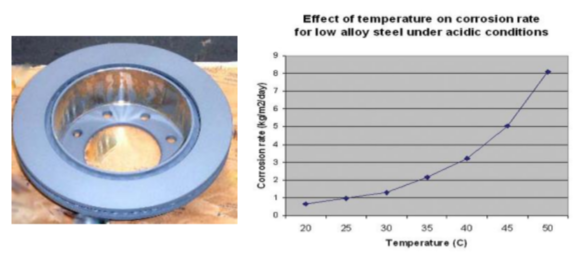
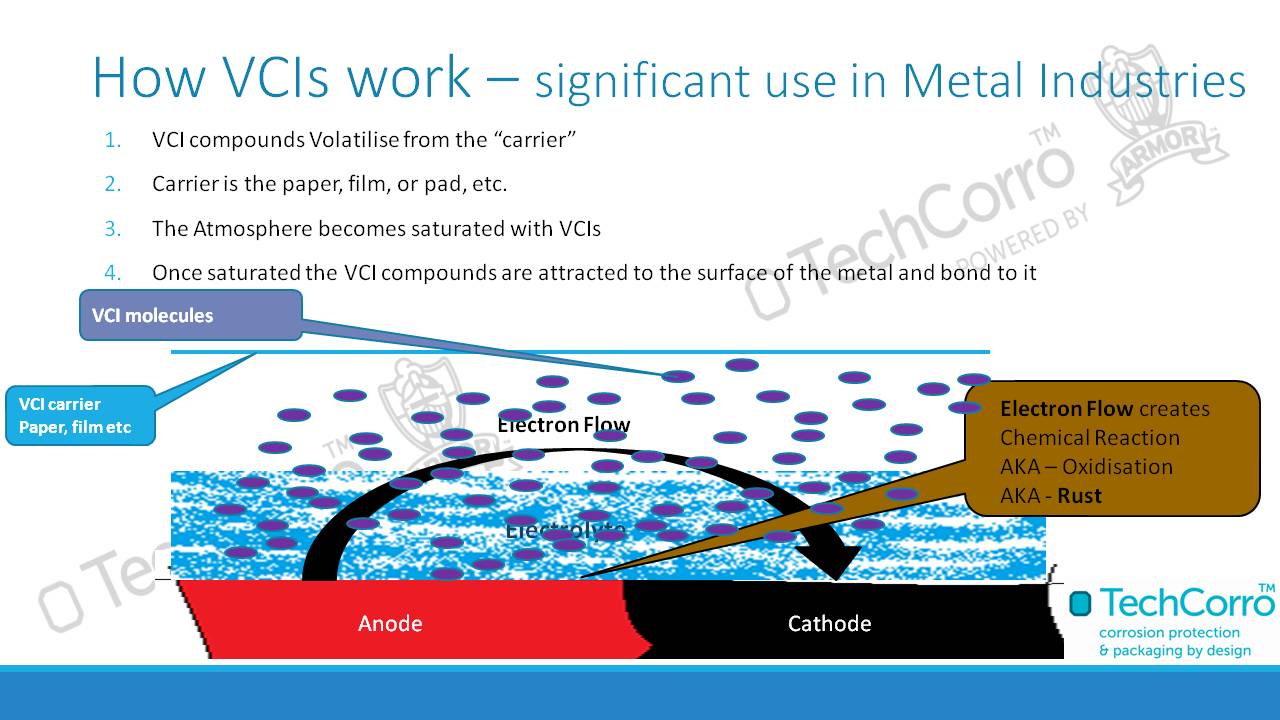




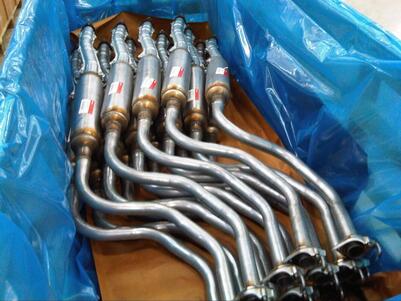


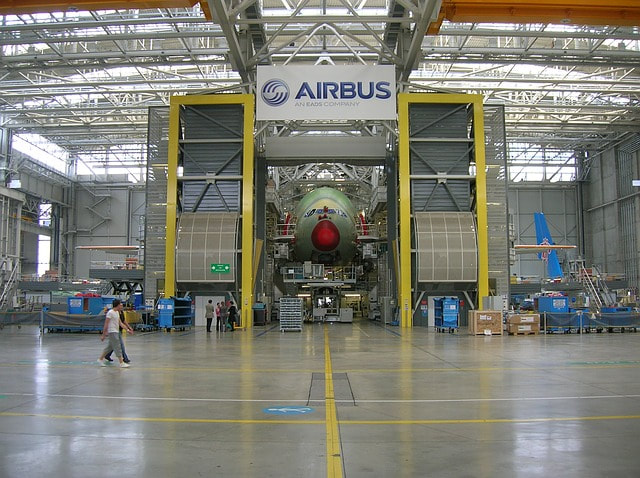
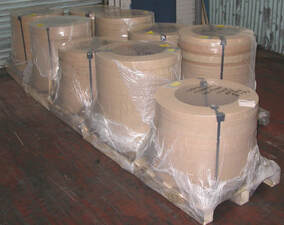
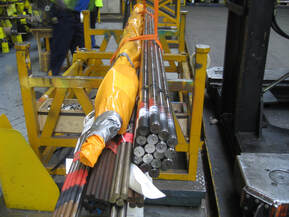
 RSS Feed
RSS Feed